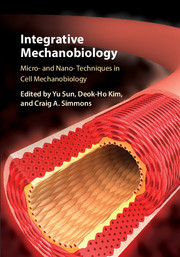Book contents
- Integrative Mechanobiology
- Integrative Mechanobiology
- Copyright page
- Contents
- Contributors
- Preface
- Part I Micro-nano techniques in cell mechanobiology
- 1 Nanotechnologies and FRET imaging in live cells
- 2 Electron microscopy and three-dimensional single-particle analysis as tools for understanding the structural basis of mechanobiology
- 3 Stretchable micropost array cytometry
- 4 Microscale generation of dynamic forces in cell culture systems
- 5 Multiscale topographical approaches for cell mechanobiology studies
- 6 Hydrogels with dynamically tunable properties
- 7 Microengineered tools for studying cell migration in electric fields
- 8 Laser ablation to investigate cell and tissue mechanics in vivo
- 9 Computational image analysis techniques for cell mechanobiology
- 10 Micro- and nanotools to probe cancer cell mechanics and mechanobiology
- 11 Stimuli-responsive polymeric substrates for cell-matrix mechanobiology
- Part II Recent progress in cell mechanobiology
- Index
- References
9 - Computational image analysis techniques for cell mechanobiology
from Part I - Micro-nano techniques in cell mechanobiology
Published online by Cambridge University Press: 05 November 2015
- Integrative Mechanobiology
- Integrative Mechanobiology
- Copyright page
- Contents
- Contributors
- Preface
- Part I Micro-nano techniques in cell mechanobiology
- 1 Nanotechnologies and FRET imaging in live cells
- 2 Electron microscopy and three-dimensional single-particle analysis as tools for understanding the structural basis of mechanobiology
- 3 Stretchable micropost array cytometry
- 4 Microscale generation of dynamic forces in cell culture systems
- 5 Multiscale topographical approaches for cell mechanobiology studies
- 6 Hydrogels with dynamically tunable properties
- 7 Microengineered tools for studying cell migration in electric fields
- 8 Laser ablation to investigate cell and tissue mechanics in vivo
- 9 Computational image analysis techniques for cell mechanobiology
- 10 Micro- and nanotools to probe cancer cell mechanics and mechanobiology
- 11 Stimuli-responsive polymeric substrates for cell-matrix mechanobiology
- Part II Recent progress in cell mechanobiology
- Index
- References
Summary
Light microscopy techniques are essential tools for visualizing the mechanobiology of cells. Computational image analysis transforms light microscopy techniques beyond tools of visualization by making it possible to extract from collected images quantitative measurements of cellular mechanical processes and to understand their behavior and mechanisms. The main goal of this chapter is to provide an up-to-date and selective review of computational image analysis techniques for cell mechanobiology applications. We aim to provide practical information to cell mechanobiology practitioners looking for image analysis techniques as well as to image analysis practitioners looking for cell mechanobiology applications. The focus of the chapter is exclusively on computational analysis techniques for dynamic fluorescence microscopy images. We first classify the images into two different categories: singe particle images and continuous region images. We then review computational analysis techniques for each category, respectively. For single particle images, we review related particle detection and particle tracking techniques and their cell mechanobiology applications. Similarly, for continuous region images, we review related region detection and region tracking techniques and their cell mechanobiology applications. We conclude with an outlook on future development of computational image analysis techniques for cell mechanobiology.
- Type
- Chapter
- Information
- Integrative MechanobiologyMicro- and Nano- Techniques in Cell Mechanobiology, pp. 148 - 168Publisher: Cambridge University PressPrint publication year: 2015



